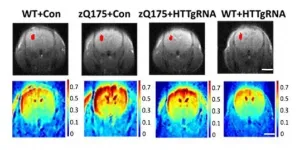(Press-News.org) Driving through a tunnel is a challenging and risky task. Drivers need to lower their speed and adapt to poor light, while the enclosed space may make them anxious. Preventing accidents is a public health challenge that uses insights from engineering, psychology, physiology, and neuroscience. Here, in a virtual reality (VR) study in Frontiers in Psychology, scientists from China, Canada, and the USA show that playback of slow music inside tunnels can reduce tension and fatigue in drivers, making them less prone to speeding and overtaking. These results imply that well-chosen background music can help improve road safety.
"When drivers go through a tunnel, they need to process a large amount of information quickly. We wanted to find the best way to use sound to keep drivers alert and focused inside tunnels. We here compare the effect on brain activity and physiology of different types of sound: slow versus fast music, warning sounds such as sirens, and a voice reminding them to drive safely," says corresponding author associate professor Yanqun Yang from the Transportation Research Center in College of Civil Engineering at Fuzhou University, China. "We show that the best solution is to play slow music inside the tunnel, but to play alarming sounds like sirens at the entry and exit or during emergencies."
Rate of accidents depends on location within tunnels
Previous research has found that accidents are less frequent in tunnels than on open roads, but that accidents that do happen inside tend to be more serious. Nor is the rate of accidents the same along a tunnel's length: for example, accidents are more likely just before or after the entrance. Once drivers are acclimatized to the special environment inside, they tend to reduce speed and move away from the tunnel wall, causing the rate of accidents to decrease. Accidents become more likely again over the middle stretch in long tunnels, because drivers may relax their vigilance from boredom.
The authors here studied whether background sounds and music might help to keep drivers relaxed but focused over the length of a long tunnel. With immersive VR, they simulated a 5100-m-long four-lane tunnel with traffic in both directions, driving between 80 and 100 kmph. They recruited 40 young women and men to act as experimental drivers - these people watched the VR on screens while inside a console that continuously recorded the pressure on the pedals, the steering wheel's angle, driving speed, and acceleration.
Yang et al. used wireless sensors to compare the drivers' neurophysiological response to five experimental sounds: a recording from a real tunnel, the slow music song "Canon" with 72 beats per minute (bpm), the fast song "Croatian rhapsody" with 96 bpm, a police siren, and a female voice warning "Please turn on the lights, slow down, and no-overtaking" or "Here is an accident blackspot, please turn on the lights and slow down."
They measured skin electrical conductance as a proxy for 'arousal', which encompasses attention, vigilance, and memory storage. Measures of heart rate and its variability served as proxies for emotional state, stress, mental load, and fatigue, while EEG measures of the brain's activity were used as proxies for wakefulness, fatigue, relaxation, and nervousness.
Slow music stimulated drivers to drive safely
Drivers drove fastest in response to fast music, and slowest in response to slow music. Comparisons of heart rate variability - typically low in people who are stressed - indicated that the drivers felt most relaxed, with a minimal mental load, when listening to slow music. This was consistent with feedback from drivers, of whom 63% chose the slow music as their preferred background.
Comparisons of the drivers' β brain waves - typically elevated in persons who are nervous or excited, and hence prone to fatigue - indicated that slow music reduced nervousness in the drivers, while voice prompts, fast music, and sirens increased it. Comparisons of the relative patterns of α, β, and θ waves - often combined in research to yield measures of fatigue - indicated that the voice prompt was most effective in preventing tiredness.
Best solution: combination of slow music with occasional sirens
The authors conclude that safety would increase if slow music would be played as a background in tunnels, while sirens should be played only at the entry, exit, and during emergencies.
"We find that slow music played as background throughout the tunnels, replaced by sirens only at spots and times when the risk of accidents is highest, is best to keep drivers alert, at ease, and not tired, while stimulating them to be extra vigilant and focused when needed," says coauthor Dr Wei Lin from the Department of Civil and Architectural Engineering and Construction Management at the University of Cincinnati, USA.
"There still a long way to go before more specific design and management recommendations can be proposed. For example, future studies should test the effect of a greater range of sounds on drivers who differ in age, driving experience, hearing sensitivity, and degree of fatigue. But our study is a proof of principle, which pushes our knowledge on road safety a step forward."
INFORMATION:
How do predators know to avoid brightly-coloured toxic prey? A collaboration of researchers has put social information theory to the test in a reliable real-world system to find the answer - by copying what others do, or do not, eat.
An international team of researchers from Finland, New Zealand, Colombia and the U.K. have provided the first evidence that wild birds can learn to avoid distasteful prey by observing what others eat.
"We've known for a long time that predators, like birds, associate brightly coloured warning signals with the danger of eating certain prey types. However, ...
Imagine a dust particle in a storm cloud, and you can get an idea of a neutron's insignificance compared to the magnitude of the molecule it inhabits.
But just as a dust mote might affect a cloud's track, a neutron can influence the energy of its molecule despite being less than one-millionth its size. And now physicists at MIT and elsewhere have successfully measured a neutron's tiny effect in a radioactive molecule.
The team has developed a new technique to produce and study short-lived radioactive molecules with neutron numbers they can precisely control. They hand-picked several isotopes of the same molecule, each with one more neutron than the next. When they measured each molecule's energy, they were able to detect small, nearly imperceptible changes of the nuclear ...
BOSTON - The numbers of cancer screening tests rebounded sharply in the last quarter of 2020, following a dramatic decline in the first months of the COVID-19 pandemic, at one large hospital system in the Northeastern United States. These findings were released in a study published in Cancer Cell. The research also found an increase in racial and socioeconomic disparities among users of some screening tests during the pandemic.
Study co-senior author Toni K. Choueiri, MD, director of the Lank Center for Genitourinary Oncology at Dana-Farber Cancer Institute, said following a dramatic decline during the first pandemic peak, there was a "substantial increase in screening procedures during the more recent periods ...
LAWRENCE -- A new paper appearing in Biology Letters describes the oldest-known fragmentary bat fossils from Asia, pushing back the evolutionary record for bats on that continent to the dawn of the Eocene and boosting the possibility that the bat family's "mysterious" origins someday might be traced to Asia.
A team based at the University of Kansas and China performed the fieldwork in the Junggar Basin -- a very remote sedimentary basin in northwest China -- to discover two fossil teeth belonging to two separate specimens of the bat, dubbed Altaynycteris aurora.
The new fossil specimens help scientists better understand ...
Dutch-French research shows that Optical Genome Mapping (OGM) detects abnormalities in chromosomes and DNA very quickly, effectively and accurately. Sometimes even better than all existing techniques together, as they describe in two proof-of-concept studies published in the American Journal of Human Genetics. This new technique could radically change the existing workflow within cytogenetic laboratories.
Human hereditary material is stored in 46 chromosomes (23 pairs). Although those chromosomes are quite stable, changes in number or structure can still occur. A well-known example is Down syndrome, which is caused by an extra ...
A decade's worth of data shows that neonatologists are shifting the type of respiratory support they utilize for preterm infants, a move that could lead to improved health outcomes.
Using two large national datasets that included more than 1 million preterm infants, researchers in a new Vanderbilt-led study found that from 2008 to 2018 there was a greater than 10% decrease in the use of mechanical ventilation for this patient population. Concurrently, there was a similar increase in the use of non-invasive respiratory support, such as continuous positive airway pressure (CPAP), for these infants.
The ...
(Boston)--The discovery of novel groups or categories within diseases, organisms and biological processes and their organization into hierarchical relationships are important and recurrent pursuits in biology and medicine, which may help elucidate group-specific vulnerabilities and ultimately novel therapeutic interventions.
Now a new study introduces a novel computational methodology and an associated software tool called K2Taxonomer, which support the automated discovery and annotation of molecular classifications at multiple levels of resolution from high-throughput bulk and single cell 'omics' data. The study includes a case ...
SILVER SPRING, Md.--Vaccines such as Pfizer, Moderna, Johnson & Johnson and AstraZeneca are designed to prevent severe Coronavirus-19 Disease (COVID-19) due to acute respiratory syndrome coronavirus 2 (SARS-CoV-2) and are highly efficacious. The efficacy is not different in people with and without obesity except for AstraZeneca which is not known, according to a new position statement from The Obesity Society (TOS), the leading scientific membership organization advancing the science-based understanding of the causes, consequences, prevention and treatment of obesity.
Trials have demonstrated high efficacy in individuals ...
In a new study on mice, Johns Hopkins Medicine researchers report that using MRI scans to measure blood volume in the brain can serve as a noninvasive way to potentially track the progress of gene editing therapies for early-stage Huntington's disease, a neurodegenerative disorder that attacks brain cells. The researchers say that by identifying and treating the mutation known to cause Huntington's disease with this type of gene therapy, before a patient starts showing symptoms, it may slow progression of the disease.
The findings of the study were published May 27 in the journal Brain.
"What's exciting about this study is the opportunity to identify a reliable biomarker that can ...
Hamilton, ON (July 7, 2021) - A McMaster University team of researchers recently discovered how, exactly, the COVID-19 vaccines that use adenovirus vectors trigger a rare but sometimes fatal blood clotting reaction called vaccine-induced immune thrombotic thrombocytopenia or VITT.
The findings will put scientists on the path of finding a way to better diagnose and treat VITT, possibly prevent it and potentially make vaccines safer.
The researchers' article was fast-tracked for publication today by the prestigious journal Nature in its accelerated article preview because of the importance of the research.
"Our work also answers important ...



